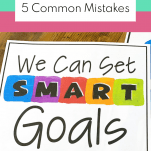SMART Goals are an incredible tool to teach students when setting goals. Well, that is if they do anything with them. Sometimes, we set goals with students and let them collect dust on the shelf. We all know that with our own goals, we have to track them and focus on them, or they will never happen. So why don't we do that with students? If you are working on goal setting with students, ensure you avoid these 5 mistakes.
Use Mini-Goals
You have to break goals down. Say I wanted to lose 100 pounds. It's much easier to break that down into 10 pounds at a time. Plus, what I must do to lose the first ten will be different than what I must do to lose the last 10.
When a football team has the ball, their goal is the end zone, but they have mini goals to keep moving the goal posts down the field. Breaking down big goals helps us feel successful, see our progress, and know we are on the right track.
Focus on 1% Better
Some of the goals students will set will be big. There will be setbacks. They must focus on minor improvements and steps forward. Celebrating 1% improvement is essential to staying motivated and understanding that improvement is a continual process.
Let Them Set the Goals
Often, we think we know what students should work on. It's not that we don't, but if it's not essential or personal to them, they will not care.
Students need to think about what they want to work on and improve. Not necessarily what adults want them to do better.
When you are setting goals with students, make sure they are:
- actively thinking about their goals,
- breaking them down,
- reflecting and tweaking,
- celebrating small successes,
- and working on what matters to them.
Get started with SMART goals using one of the resources below.
Goal Setting Activities

Football-Themed Goal Setting Activities
This football-themed resource tracks student progress, keeps them motivated, and teaches them to set individual goals.





















Valuable tips! Teaching your child to set goals and achieve them is one of the main tasks of a parent and an educator.
You know, nowadays adults even pay money to other people to be taught how to set goals. What a silly thing to do!
That’s why it’s important to teach kids this at a young age.